Disappearing City: Payphone booths, Central
Written, Directed and Edited by Cheung Wan Suet, Yvonne, 3036234401
Video link: https://youtu.be/aOsq34dxst4
Theme and Description
Central district, crammed with bustling traffic and looming skyscrapers, is the heart of this metropolitan and cosmopolitan city. Everybody here is occupied and is supposed to be occupied with something, living at the fastest pace, embracing the newest changes. All the happenings in here are in an indifferent state of transience and a non-occurrence.
The existing payphone is also in a state of transience, silently waiting for its impending death. In the 90s, it was at its prime time when people used pagers to communicate with each other, with more than 1,500 payphone booths installed in Hong Kong Island, Kowloon and New Territories. However, the development of technology has been at an unimaginable speed. Calling has become more and more accessible and easy, mobile phone with signals and automatic Internet access is payphone’s biggest enemy and the obvious reason for its replacement. The price of the payphone has stayed at $1 for a 5-minute call since 1997 until today. It seems to represent that the payphone has been stagnant, unaffected by inflation, unaffected by the passage of time and the rapid advancement of the city.
According to the Office of Communications Authority, public payphones have an “extremely low usage rate” and generate an average of HK$1 revenue a day, with around 56 per cent of them earning less. Besides, it also takes up too much space — in 2019, about 46 per cent of the city’s 3,400 public payphones are in street kiosks — and at the age of capitalism, pragmatism and efficiency are the priorities. Therefore, in 2019, the Office of Communications Authority decided to demolish 765 of the 1529 payphone booths in the city, and the demolition plan was further accelerated because of the pandemic.
Will it vanish? The answer tends to be positive. Or it is better to say it will eventually be replaced. Since April 2023, the new Smart Kiosks started to appear on the street, with brand new functions like free Wi-Fi service, USB charging spot, news, maps, traffic information and event weather forecast. Calling ceases to be the main purpose of the kiosk, it becomes a secondary function. Moreover, organizations with inventive minds like Designing Hong Kong also suggest its transformation into top-up machines, mini-shops, interactive art statues, and many more.
Also very interestingly, the first payphone ever in Hong Kong was installed in Wyndham Street, Central in 1951, and the first installments of the Smart Kiosk also happened in Central District. It is also the only district that you can witness the transformation of the payphone booths. With the two British colonial style red payphone booths in the Western Market for memorial purpose, to ordinary payphones and eventually the Smart Kiosks on Connaught Road, Queen’s Road Central, Des Voeux Road Central and Chater Road. Therefore, I chose Central as the district to focus on as it chronicles the rise, the decline, and the rebirth of the payphone booth.
Methodologyand Reflection
I conduct my research primarily by fieldworks and online research. I paid attention whenever I walked on the street of Central and marked down the locations of every payphone booth that I encountered, I also paid attention to people’s interactions with it, most of them know its existence, but do not notice its existence. For online research, I failed to find formal academic publications with its research topic on payphones (which is a sad fact), so I focused on government regulations and news articles, firstly in Hong Kong, and secondly in other parts of the world. As a result, I could observe a similar trend of payphone around the world — that is disappearing, or transforming into something that fits the modern utilitarian purpose and aesthetics more.
I used a FujiFilm X-T30 camera to record all the footage within one day, from late afternoon, to evening, and to mid-night. I moved eastward as the time passed, I looked towards right, it symbolised the progression into the future and the passage of time. I started with a few footages of the red payphone booth in Western Market and the streets scenery in Sheung Wan when there was still daylight, then shots of ordinary blue payphone booths as the sky dimmed and became more grey, after that when the darkness come it was the Smart Kiosks, and I ended with a tripod shot of the deserted street of Central during mid-night.
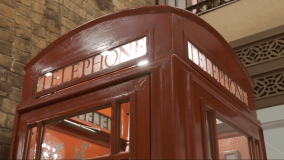 .
. 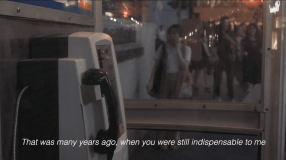
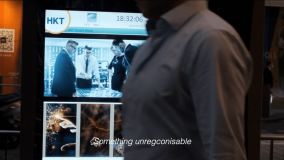 .
. 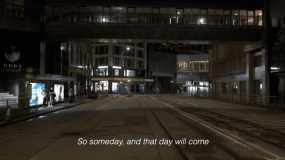
I did not purposedly choose to shoot this on a rainy day, but I did intend to establish a sad undertone. Therefore, the gloomy weather also inspired my artistic expressions. I framed the camera so that the footages are not solely focus on the subject matter, but also its relations to the people, and to its surroundings: the gigantic LED displays, commercial advertisement, office workers finishing works, people smoking. etc. I want to express a sense of isolation and alienation, and emphasis the contrast, the irony, and the very disposable nature of the payphone booth in this era.
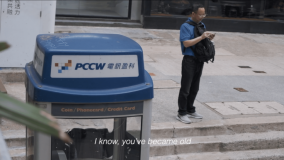 .
. 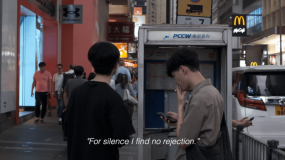
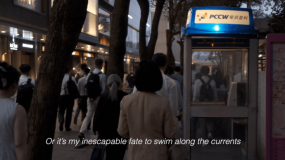 .
. 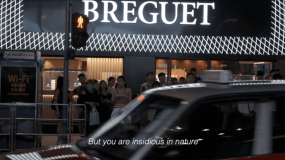
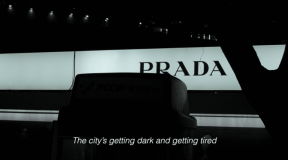 .
. 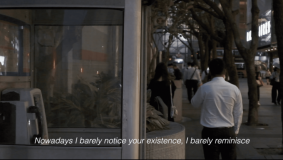
I used a more creative approach and added poetic lyrics to the video, it is a metaphor of our relation to the payphone — I personified the payphone and directly addressed it as “you”, and trying to unravel the intricate tangle between us: you were once important to me, but changes are inevitable, the currents of time push me forward and leave you behind. I seldom look back, but you are always there as a collective reminder of the beautiful past, waiting for me to look back. But one day you will eventually fade away.
I used the original sound effects recorded, it is the sounds of a busy Monday in Central. I did not add any voiceover or dialogue as I just wanted to emphasise the indifference, and the muted, invisible human connections nowadays without the payphone. I am not trying to express a conservative attitude towards technology and a pessimism about future, but the little sense of helplessness and nostalgia that are found in immense optimism of the future. I really enjoyed the making of this short film.
Bibliography
“【經緯線】被遺忘的電話亭.” Now 財經新聞, September 4, 2023. https://www.youtube.com/watch?v=wzy1VRun7u0&ab_channel=Now%E8%B2%A1%E7%B6%93%E6%96%B0%E8%81%9E.
“Chapter 23: Local and International Telephone Calls and Internet Access.” Home Affairs Department. Accessed May 14, 2024. https://www.had.gov.hk/rru/en/images/pdf/Your_Guide_to_Services_in_HK_English_chapter_23.pdf.
Creery, Jennifer. “In Pictures: Top-Ups, Toilets or Teleportal – How to Repurpose Hong Kong’s 2,900 Payphone Booths?” Hong Kong Free Press HKFP, March 23, 2019. https://hongkongfp.com/2019/03/23/pictures-top-ups-toilets-teleportal-repurpose-hong-kongs-2900-payphone-booths/.
大紀元時報. “【紀載香港】電話變成副產品? 公眾收費電話亭話今昔.” July 9, 2023. https://hk.epochtimes.com/news/2023-07-09/245412.
Dimsum Daily. “Hong Kong Telecom Launches Smart Phone Kiosk Pilot Scheme in Causeway Bay to Boost Smart City Development.” April 30, 2023. https://www.dimsumdaily.hk/hong-kong-telecom-launches-smart-phone-kiosk-pilot-scheme-in-causeway-bay-to-boost-smart-city-development/.
“HKT Launches Pilot Smart Kiosk Scheme.” PCCW, n.d. https://www.pccw.com/assets/Common/files/press-release/2023/Apr/20230427e%20HKT%20Smart%20Kiosk.pdf.
Kollewe, Julia. “Thousands of UK Phone Boxes to Be Protected from Closure.” The Guardian, November 9, 2021, sec. Business. https://www.theguardian.com/business/2021/nov/09/uk-phone-boxes-bt-poor-mobile-coverage.
Now 新聞. “【經緯線本周提要】約一半電話亭已被拆除 電訊公司推出智慧電話亭.” September 2, 2023. https://news.now.com/home/local/player?newsId=530741.
“Register of Public Payphone.” Office of the Communications Authority, March 15, 2024. https://www.ofca.gov.hk/filemanager/ofca/common/media/data_stat/Register_of_Public_Payphone.pdf.
Sharp, Sarah Rose. “NYC’s Last Public Pay Phone Is Now a Museum Artifact.” Hyperallergic, June 22, 2022. https://hyperallergic.com/741920/nycs-last-public-pay-phone-is-now-a-museum-artifact/.
South China Morning Post. “Should Hong Kong Say Goodbye to Public Phone Booths When More than Half of Them Earn Less than HK$1 a Day?” January 19, 2019. https://www.scmp.com/news/hong-kong/society/article/2182603/should-hong-kong-say-goodbye-public-phone-booths-when-more.
Statista. “Australia – Payphone in Operation 2019,” January 3, 2023. https://www.statista.com/statistics/863733/australia-payphone-in-operation/.
Statista. “Number of Public Pay Phones in Germany from 2006 to 2020,” November 28, 2022. https://www.statista.com/statistics/491083/public-pay-phones-germany/.
The Irish Times. “Last Call: Country’s Few Remaining Payphone Boxes to Be Removed after Almost a Century.” Accessed May 14, 2024. https://www.irishtimes.com/ireland/2024/02/22/last-call-countrys-few-remaining-payphone-boxes-to-be-removed-after-almost-a-century/.
“TVB探古尋源|公眾收費電話亭.” 無線新聞 TVB News Official, July 31, 2023. https://www.youtube.com/watch?v=lv9c127BZG4&ab_channel=%E7%84%A1%E7%B6%AB%E6%96%B0%E8%81%9ETVBNEWSOfficial.
Veloxity. “NYC Pay Phones Going Solar, Are Cell Phone Charging Stations Next? | Veloxity.” September 1, 2015. https://veloxity.us/cell-phone-charging-stations-nyc/.
Wanted in Rome. “Italy Hangs up Its Last Public Pay Phones.” May 27, 2023. https://www.wantedinrome.com/news/italy-hangs-up-its-last-public-pay-phones.html.
Cheung Wan Suet, Yvonne, 3036234401